|
|
Post by reTrEaD on Dec 16, 2011 22:45:44 GMT -5
This is more along the lines I was thinking of, but a little in the dark about the concerns that have been raised re active circuits, surely the same thing happens with any guitar with a volume control and an active buffer as is often suggested? blend is such that there is signal in to the centre lug, signal out one side, ground at the other...in the current scheme. It's not common to have a blender after an active buffer. So we're in new territory. The common way of doing a blender has the pots wired "backward" as you just described, with the input on the wipers. Best to avoid that. I think either John's scheme with a single-gang 100k linear blend or the more recent scheme with the 500k stewmac blend pot wired CORRECTLY will be better than the stewmac wiring. But I had some more thoughts about the circuit, and i think there may be a very nice way to use the Stewmac pots that you ordered, if they turn out to be the type that provide full output at the mid detent. I promise you will like this one.....!   So, mag pup goes to buffer. Then dual-gang master volume, 100k log. (its 100k so it can be followed with a 500k blend pot). Then to the Stewmac blender. On the diagram, I�ve put a heavy line on the half of each half pot that has low/zero resistance. So the signals after the blend pot, with volume at max and blend half way, are each the full pickup signals. Then there are resistors, I�m suggesting 47k or 100k but that could be reviewed, then buffers to two outputs. So you have your two stereo outputs, each under master volume and blend-pot control. Actually in stereo mode, I would call the action of the �blend� pot a �balance� pot ie, it is adjusting the levels of two signals but not mixing them. Then, the final feature, the mono stereo switch � which joins the two channels to combine them. It happens after the resistors, so no distortion due to shorting active circuits together. In mono mode, you have two outputs of the blended mix. The gradualness of the blending depends on the resistor value � actually 100k instead of 47k will give a more gradual blend. The mono/stereo switch could be part of one of the output jacks (needs an isolated switch as shown, but it could be adapted to use a simple switched jack). But, I think it would be much fun to have a separate mono/stereo switch. You could use it at a poignant moment to make a leap from a centrally placed mono blend to the two channel stereo image. Cool? ReTread, Ash, newey and others � what do you guys think? John I'm wondering if a blendpot that has full output at the midpoint will cause a different set of problems in this application. In "stereo" mode, when the control is rotated from center, one side is reduced in volume, but the other doesn't increase. It just says the same. This is a little different from the way a "balance control" operates. Not necessarily bad, but not what one might expect. The other problem will be in "mono" mode. As we move from midpoint toward the mag end of the rotation, the mag signal at the wiper isn't increasing. But the resistance at the piezo wiper will first rise to a maximum of 125k, then decrease to zero. If we look at it from the standpoint of the wiper resistance being in series with the bottom of the voltage divider, the volume of the mag signal will have a bit of a hump somewhere between midpoint and full rotation toward mag. A blend pot with a gradient from end to end would probably be better than one with full output at the midpoint. At least in this application. I guess we should wait til 4real can tell us what's in those stewmac blenders. fwiw, I made a spreadsheet based on this diagram. 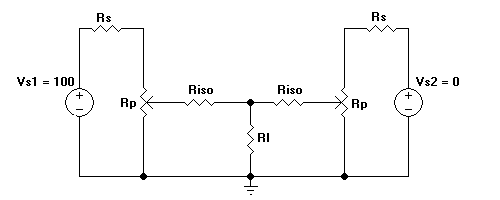  It's meant to evaluate the interaction of tying two wipers together. The Y axis of the graph is the output voltage at the load when the left hand pot is rotated. I can select the voltage on either source, both source resistors are inputted from a single field, as is the value for both pots. The value of the right hand pot is at a constant value (percentage of rotation) I have a range of 20 values (5% increments) for the rotation of the left hand pot. The result is a graph. Since the increments are linear, the results should be linear. Any deviation from a straight slope suggests "abruptness" or "flatness" in that portion of the rotation. Here's an example: 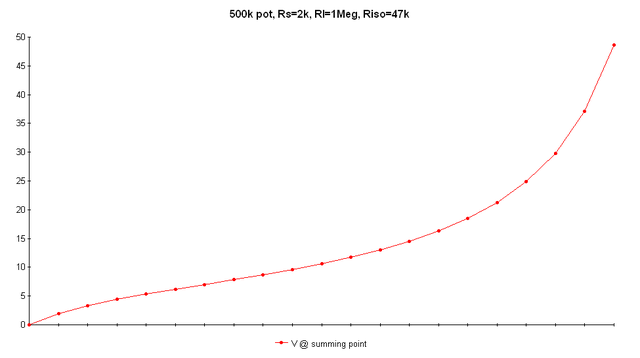  This might be useful along the way. |
|
|
|
Post by JohnH on Dec 17, 2011 16:31:50 GMT -5
Yes they all have hairs on them!
All my sketch diagrams up until the last, used a single-gang linear pot for blending, and i still think this is the best form of blender between two active sources because output volume is conistent, assuming consistent input. The last one I drew with the Stewmac pot, drops in volume at each end of the blend.
I think it would be interesting to decide what is the perfect action for this design that 4real envisions, in which the ‘blend’ pot does double duty as either a blender of two signals to a mono output, or a balance control controlling relative levels of two separate stereo channels.
I think the best way to consider this is if both signals are thought of as identical. In that case, in mono/blender mode, one might wish for zero difference in output volume across the blend range, in which the component from each source changes steadily. The output level should be that of the natural output of one pickups. The single linear pot can do this, so at least that part has an answer.
In stereo mode, I think the ideal would be that the power output stays constant as you pan. This will mean that the power from each channel in the mid position is -3db down, so total power from both added is unchanged. This means signal voltage has to be at 70% on each channel at the mid point. At extreme ends, one channel is off and the other is at 0db ie full output. So with pot panned fully one way, there would be full output from one channel whether the pot was in mono blend or stereo balance mode.
So its off to the sketch pad to figure out the easiest way to do both of those....
|
|
|
|
Post by reTrEaD on Dec 17, 2011 16:49:37 GMT -5
I was messin' around with the spreadsheet again. The chart below shows 3 different conditions 1 - Left pot goes from 0 -> 100%, right pot held at 100% 2 - Left pot goes from 0 -> 100%, right pot goes from 100 -> 0%. 2 - Left pot goes from 0 -> 100 -> 100%, right pot goes from -> 100 ->100% -> 0%.   These are under the same conditions as before. Rload=1Meg Rpot=500k Rsource=2k Risolation=47k I was pleased at how nicely the pots act when the rotation is contrary. Risolation can be much lower without problems. Since this represents the action of linear pots, it doesn't translate directly to log pots. But it seems encouraging for pots that have resistance from end to end and troubling for pots that have maximum output for half the rotation. If you'd like to see the results for other values of resistors and pots, let me know. |
|
|
|
Post by reTrEaD on Dec 17, 2011 16:53:05 GMT -5
All my sketch diagrams up until the last, used a single-gang linear pot for blending, and i still think this is the best form of blender between two active sources because output volume is conistent, assuming consistent input. Even though it isn't perfect in "separation", I very much like the way it functions. |
|
|
|
Post by JohnH on Dec 17, 2011 17:06:11 GMT -5
All my sketch diagrams up until the last, used a single-gang linear pot for blending, and i still think this is the best form of blender between two active sources because output volume is conistent, assuming consistent input. Even though it isn't perfect in "separation", I very much like the way it functions. thks - if you view back through earlier pages, you'll see different versions of it. mostly they have better separation, if a 100k or 500k pot is wired directly across two active outputs. It depends on pot R to output z ratios. The last one was to put a 500k blender after a 100k volume pot pair, which had a lower such ratio, but still OK acording to numbers. |
|
|
|
Post by 4real on Dec 18, 2011 18:05:46 GMT -5
Thanks to everyone for all these replies and interest in my humble project, I really am impressed. SO, back from the weekend, well, I was here...so free again and likely opting out for christmas an hibernating island side for a bit in an effort to avoid as much as I can of the whole thing....hmmm
Still...while I have not got through all of things, something did occur to me, in the socket for the piezo I have two NC switches that open when a plug is connected. One could use this to perhaps switch power off to buffers if having them hung is a concern there when working in mono/blend mode...the most likely use for this guitar as a whole. Not sure if this helps.
Similarly, the buffer on the mag is currently wired with the master volume after the buffer, but it need not be I guess, could be after I suppose. Had been thinking of getting the piezo/mag to a similar impedance and making the possibility of a passive mag a little easier with a conventional 500K pot.
A mono/stereo switch, well possibly, it would be an interesting capability perhaps...it might be less distracting to have a central blend across two amps and the spread for an effect. The main intention though was to optimise one side for acoustic sound and the other for electric. The guitar does seem to work more effectively through the old 'roland' than the fender which I love for the electric sounds.
Not sure how long the blend pot will take to get here to test out how it works or in a design. I have a house inspection tomorrow so keeping the place in some semblance of tidy that working on this and other things often threatens LOL....but later in the week might try a few more things with the guitar.
Thanks again and hopefully we will have this 'licked' in the near future.
|
|
|
|
Post by JohnH on Dec 18, 2011 22:08:41 GMT -5
Hi Pete – I’m sure we will get to a great design.
It turns out to be tricky to get a pot/dual gang to behave as a perfect mono blender, and also a perfect stereo balance pot. But I have a version in mind which might do it better than the previous designs. It uses parts that you probably have, being a dual 100k lin for the blend/balance, and a 470k log dual for the master volume. The way it blends is akin to the single pots that I have been sketching, but uses part of the two pot halves to do it. Diagram needed. Extra parts are a couple of probably 39k resistors and, and a switch (3 or 4 pole toggle) to change from mono blend to stereo mode. It needs these poles to do the reconfiguration needed. When done, it should have good consistent volumes and smooth transitions in all modes (based on my last post).
If you are interested to keep exploring towards such a system, it would be good to test the blending at your end, because from the diagrams that you posted, I think you may not yet have tested the uses of a linear blender in the way that I have mostly drawn it. So, science request: rig up this simple system:
Mag pickup feeds into a buffer
Take a single 100k linear pot (or half a double) one outer lug goes to mag buffer, other outer lug goes to piezo preamp, central lug goes to guitar amp.
No volume controls (added later) and no switches/resistors yet, but how is the blending?
Cheers
John
|
|
|
|
Post by gumbo on Dec 19, 2011 5:56:47 GMT -5
Yeah...good plan John... ...anything that stops him taking all those agonising beach photos is a good idea too...  |
|
|
|
Post by 4real on Dec 19, 2011 16:35:17 GMT -5
The way I tested it originally to get to the current config was a vol on the mag only, then on to the output...that's why the piezo got wired back to the volume. The middle of the blend was a bit quieter than either end and still is much the same as is. The buffer before the volume might not have been the best idea as I'm getting the idea that the vol changes the impedance. When I get a chance I will reverse the blend connections and see what happens...still not sure where things are going and the 500K blends coming with the centre detent might well be the better part and at $20 with post, might as well try to use it. The diagrams offered are interesting but I need to wait for the blend pots to arrive and the 100K pots are linear. 4pdt switches are not a problem as are other switches but it is tricky and tedious wiring all in shielding with everything hanging out the back of the guitar as it is. Not quite getting why the lower value pot should precede the larger one as seems to be the case and influenced the purchases there and how we have gone from perhaps 4 buffers to the simple one and all that...and didn't anticipate that these kinds of active systems could be wired to kill batteries and such when wired as what seems to be normal volume controls (grounding to earth)... ... Beach...well, the tan is coming along despite the weather being a bit odd...since you mentioned it in a patently disguise a request there...an early evening stroll with the GF caught some surfing action...   Still...it would be good to have the guitar wired and played again without wires hanging out all over...there are still a few construction things to work out and this aspect is not matching the 'vision' as I had for it... |
|
|
|
Post by JohnH on Dec 20, 2011 6:25:15 GMT -5
Appologies if Ive been jumping around posting too many diagrams. Heres one more, and I'll shut up for a while.  This one uses the dual linear 100k pot for blend or stereo balance and 470k log for volumes. I think it is the smoothest and most consistent so far, but would need testing. So Ill just park it here. |
|
|
|
Post by 4real on Dec 20, 2011 6:51:29 GMT -5
Thanks John, looking good and will try and study it further...be a shame not to use the 500K blends though...hmmm...still...looks promising... Well, there are a lot of diagrams, but then it is taking me a bit to get to grips with the issues at hand and I suspect that these wont be wasted. I'd not been completely convinced ever of 'active guitars' but I plan to put one in the jack socket of my strat and the blend/balance thing could easily have many applications...I'm only sorry if I ahve not been holding up my end...perhaps tomorrow I might get a chance to work on this one as at least I have the parts for that...better than the stew mack blend do you think? I like the clever use of the switch to take it out one of the gangs as it appears and add in the resistors required...hopefully I can find some that or near to that value...what is the purpose of these in the scheme of things? I'm just back from the carols on the island and that may well be enough Christmas for this year...  Got a lot of pics, but as my little camera isn't really for night time, might as well have some fun with it...like this... 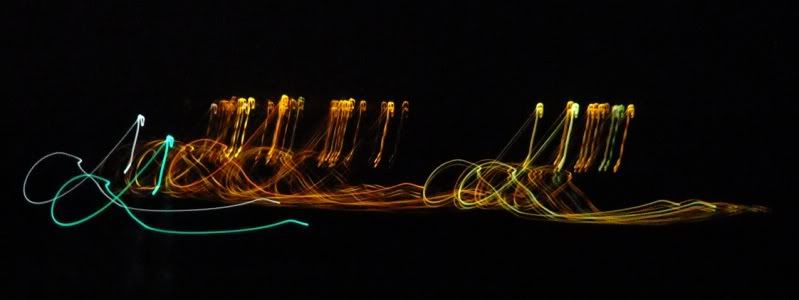 A boat on the water... 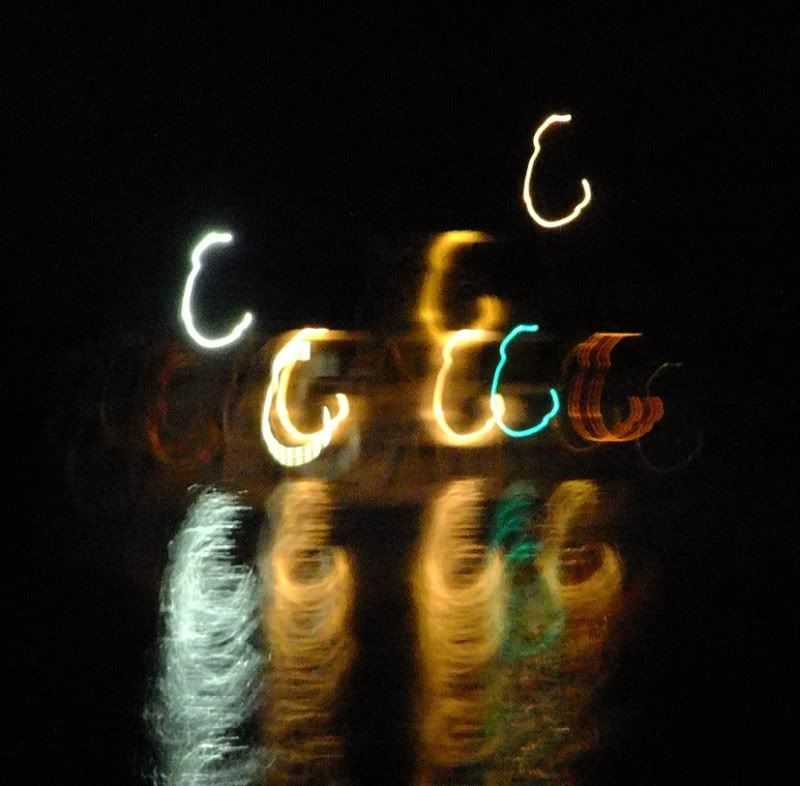 Carols, brass band, guitar players, light sabre fights and fireworks on the beach and well before the craziness that is Christmas time so people still in a good mood and over by 10 pm... |
|
|
|
Post by JohnH on Dec 20, 2011 7:09:58 GMT -5
Thanks Pete - i think this one is promising. The 39k's come into play in stereo mode, and they compensate for what theortically may otherwise be a dip in volume when each channel is at 50%. If you try it without you can see if the theory is right. The thing is, two channels each at 50% means each is 6db down. Added togther you are still 3db down. But the resistors keep overall volume contant as you pan in stereo.
cheers
John
|
|
|
|
Post by 4real on Dec 20, 2011 7:17:11 GMT -5
Thanks, this is indeed the case that the guitar is louder at each end of the blend...all this resistance does not ask for some kind of boost to the overall signal?
|
|
|
|
Post by JohnH on Dec 20, 2011 14:30:17 GMT -5
Its partly related to the values used, with larger values following smaller ones. This layoit shpu;d have no more than about 1db of volume variation at mid blend compared to all one way, assuming both signals were the same. Thats pretty close, but in practice, since the signals are not the same, you might sense a reuction in volume of each one. Gotta try it to find out!
Going into your pair of guitar amps, you could omit the two buffers on the output to test it. then, if you are happy with the control action but feel like some more overall level, I can fix you up with a boosted buffer design if needed.
John
|
|
|
|
Post by 4real on Dec 21, 2011 5:54:31 GMT -5
I didn't get a chance today, but hopefully tomorrow. I will make a another plate for the blend pot that can hold a blend/parallel switch...the switch will need to move in an up and down way rather than side to side as with the others, but that is ok and checked out the switch and found a pack of resistors that include 39K's today.
The plan is to redo the whole thing, perhaps with a bit more organised and less piece-meal as with this last scheme. It means taking everything apart but I was not pleased with the scrapy-ness of the wiring anyway really.
I will also have to ditch the passive switch really, it didn't sound too good anyway and hopefully I have fixed some of the 'problems' with the new battery and power switching at the jack socket (will just have to get used to unplugging the guitar more often and keep a spare battery handy.
I was wondering, I know I have asked this before, but...would a phase switch have an effect with the piezo or any advantage...I could easily do that or something similar with the spare 'switch' possibility.
The stereo blend switch does sound like an interesting prospect performance wise. The main reason for the stereo thing really is to optimise the amp sound for the piezo and it does sound better through my SS amp for sure.
It occurs to me that I have a BR-600 that I rarely use but could be bent to a powerful tool. Not overly keen on using a drum machine, though it can do that well so, at least there is a metronome there. But it has a huge range of great roland effects in it of all kinds...plus a second channel for vocals that may well suit the piezo side....plus, hit the record button and I'd have a record of it that I could upload into a computer recorder if I play something worth preserving.
Eventually I may well develop a pedal board kind of thing for performance even though the sound is to be fairly natural, there are some interesting possibilities and the hex things might well need that kind of thing. It could also perhaps add a gain stage if the guitar is innately a little low in output compared to a typical guitar.
Thanks again john and all, and for all the interest on this project...after all this, I might have to build another LOL...
|
|
|
|
Post by JohnH on Dec 21, 2011 7:22:51 GMT -5
On the phase switch, it may well have an effect. On my system, to get in phase with the piezo, I had to reverse all the mag pup phases. It was not something that could be predicted, so until you try it both ways, you may not know which phase is better or if it actually has a significant effect. iIwas actually expecting the piezo and mag to be out of phase not by 180 degress, but by 90 degrees, since they work is such different ways.
Good luck!
|
|
|
|
Post by 4real on Dec 22, 2011 1:21:40 GMT -5
Ok...well...
After many hours of re-soldering and little trouble shooting at the end...
It half works LOL...
Imade another brass plate and mounted the 4pdt to it with the blender and built it in two modules...it is a lot more complicated in reality like this than in the diagram, but one connection at a time and I think I got it 'first go'' except for failing on the final hurdle to get power in from the socket switch (thank goodness for the multimeter) and it powered up...
The blend mode seems to work...gone is the big jump in volume at either end of the control and seems to be running smoothly.
Comparing it with the tele and there is a significant difference in loudness, so perhaps pre-amps will be necessary to boost this up to something normal after all.
However, the stereo mode is not working as it should. On one side I do get the piezo...cancel that...a little bit more fiddling and things are better...working in stereo but the mag is significantly quieter than the piezo even with it's preamp on half way and the whole guitar ahlf the output of a conventional guitar for reasons unknown...
Ok, so working in both modes, will need to play with it a bit more to get a feel for how things are going and if there is some intermintant problem going on.
One has to wonder though, the mag side has a conventional, admittedly not high output PAF in here and would think that would be loud enough, especially with a buffer attached...a bit of mystery at work here. Tride swapping amps over and all that.
Little if any difference is experienced by the series parallel switching which is a shame, so to the phase switch that seems to have no effect in relation to the piezo either way. I might need to investigate this a little more, but it seems to be working and no noise...hmmm.
...
However, the controls do run smoothly and function as expected with a little teething problems perhaps. The wiring is neat and there is little if any noise unless you boost the piezo presence control a lot!
So, I have it wired as per the last diagram...any thoughts onhow to boost the thing, perhaps just boost the mag or something. How about these three switches on the HB, they seem to have little effect other than the tone switch, thoughts? (or is that a clue that something is wrong?)
So, have some pics but for now a glorious day of 27C and I think I should get out of the house, perhaps even take a short dip before dinner...
later then...
|
|
|
|
Post by JohnH on Dec 22, 2011 3:32:56 GMT -5
Good work – encouraging I think. I’m glad you have a blending blender (told ya it would work!)
It would be good to sort out these volumes and relative volumes, so a few questions to carefully consider.
In blend mode, if fully blended to mag, and in stereo mode, if fully panned to mag, the output should be the same. Is that true?
When you balance the Piezo volume so you have a smooth reasonably consistent volume as you blend from Piezo to mag, do you also have reasonably consistent volume in stereo mode as you pan? When so set, with mid setting in stereo mode, you should get equal volume on both channels?
Did you find the 39k resistors? They are part of keeping volume consistent in stereo mode as you pan.
In terms of overall volume, if you plug one amp in, in mono blend mode, you should get about the same total loudness as having two amps plugged in stereo mode.
We need to figure out if there’s something not quite right or not, and if boosting is needed, whether to boost the mag buffer or one or both output buffers.
|
|
|
|
Post by JohnH on Dec 22, 2011 14:56:52 GMT -5
Pickup volumeI had a thought about the magnetic volume issue, based on string theory... en.wikipedia.org/wiki/String_theory...actually not that theory (although it may be related in some deep and fundamental way) I mean what type of strings are you using? If they are acoustic type phosphor bronze, you'd likely get much less volume on the wound strings than on a nickle coated set as on an electric guitar, since they have more ferrous metal in them. Here's a couple of discussions on this issue: michaelmesser.proboards.com/index.cgi?board=talkingblues&action=display&thread=725 www.guitarseminars.com/forum/viewtopic.php?f=1&t=6237Could that be what is happening? Tone optionsOn magnetic tone options, if you have some switches which are not doing much, you could use them to switch in some caps directly across the mag PU. You'd want to fiddle with some values but, as a contrast to a bright buffered sound, a 2nF will roll the highs off in the same way as a long guitar cord, then you might like to try higher options like 5, 10 or 20nF. It's quite nice to have a very muted sound form the mag, mixed in with the edgy piezo tone.
|
|
|
|
Post by 4real on Dec 22, 2011 17:09:24 GMT -5
Thanks John,
took off to the beach and a late night with a neighbour...so best to give this a rest for the day...will be testing a few things out later today.
The strings are 10-52 electric strings, so that should not be an issue there...I consider this an electric guitar...no advanced theoretical hidden forces at work.
I have a 'dark' switch which adds in tone cap to ground for that muffled tone that works well. The S/P sound is little different if any from the series it seems and the phase switch in relation to the piezo has no real effect...
The entire guitar is strangely low in volume compared to other guitars, sounds ok but requires a lot more amplification. I can push the piezo harder and is louder, but make for a poor balance. I will check out the wiring a bit more and see if I can get some kind of reference point, upload some pics and that sort of thing.
Connecting to normal inputs of guitar amps is ok, or should I be a low impedance input (as on my roland amp)?
I'll check the wiring again, but it seems to be wired right and working as expected...I'll see if the computer behaves for recording and make some kind of demo perhaps. However, it does seem odd, one would think that the mag side at least should be similar to any other guitar and the piezo has a preamp (though this could be pushed a lot harder)...the phase switch I thought might reveal any 'conflicts' or cancellations there, but there seem to be none...but further testing later...
thanks
|
|
|
|
Post by JohnH on Dec 22, 2011 18:02:14 GMT -5
If you are running straight from the volume pot(s) to amp(s), then high impedance guitar amp inputs are what you want. If you have built the two output buffers, then you can use either guitar amp inputs or low impedance inputs. PhaseWhen I first wired mine up, with a very simple circuit, I found phase switching made no difference in the blends. As I mentioned above, I reckon the two signals are 90 degrees out of phase, not 0 or 180 as with two magnetic pickups. The reason would be that, thinking about the fundamental tone, a magnetic pup makes its greatest output when the rate of flux change is greatest, which is when the string is crossing the centre of its wave at maximum speed. A Piezo however, is only sensitive to what is transferred at the bridge, which is derived from the string tension. The maximum string tension occurs not at the centre of the strings swing, but at the peaks, ie 90 degrees different. If you 180 degree reverse the phase of one signal, which was 90 degrees out of phase with another, it just changes from say -90 to +90, ie, its still 90 difference and will sound the same. Thats what I first noted, and maybe what you are finding with your phase switch But when I had completed my system, I had added a tone network to fix the Piezo sound. These things add their own phase shifts and so I then seemed to find that the phase started to become important again But, I just did a test: www.soundclick.com/bands/page_songInfo.cfm?bandID=674084&songID=11309256Three parts, with pure Piezo, then Piezo mixed with neck, then same with neck phase reversed. The difference between the two blended sounds is slight if any! Heres another, this time blended a bit more towards piezo, then the mag component phase reversed: www.soundclick.com/bands/page_songInfo.cfm?bandID=674084&songID=11309373The difference is more noticeable John |
|
|
|
Post by sumgai on Dec 22, 2011 22:24:56 GMT -5
John, Methinks we're back to the discussion on harmonics, as recounted in reTread's Mythbusters, Episode 1.  But here's yet another item to consider: Recall ChrisK's proviso that strings do not vibrate in a single plane - the vibrational plane actually rotates about a common axis (the centerline of the string at rest), each swing passing through that centerline in a non-orthagonal direction. Thus, at any given moment, the string's vibrational plane may be very nearly perpendicular to the magnetic field of the pole, and within an eyeblink, that plane will have rotated to be almost perfectly parallel to the magnetic field. This happens only when considering an incividual node, or any other single instance of the string's length. Knowing that each node represents a "zero deviation" from the centerline at some point in time, we also know that not all nodes line up so as to come to 'rest' at the same time, every time. Hence, while the rotational motion taking place at the 12th fret may be perpendicular, the same motion may be parallel (or otherwise!) at the 19th fret. Now imagine not only fretting the string somewhere along the neck, but the fact that there are is nearly an infinite number of nodes, regardless of the string's length. That kind of interaction is what requires King-Kong sized computers when it comes to representational modeling, or to be more precise, when it comes to modelling so accurately that you can't tell if it's real, or if it's Memorex.  HTH sumgai |
|
|
|
Post by 4real on Dec 23, 2011 0:39:11 GMT -5
No time yet today to work on this, perhaps later the in the evening...silly season and an very hot day out... So, here are some pics of yesterdays work... 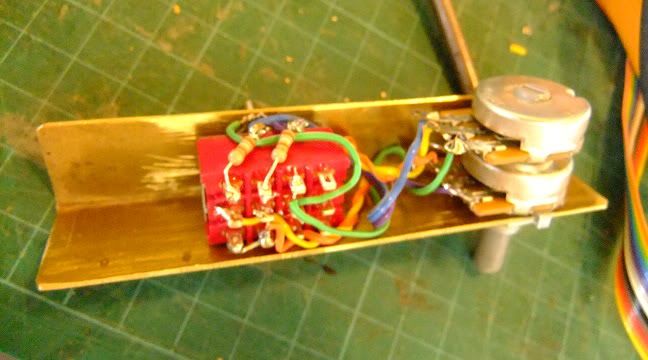 The new 'blender' brass plate and stereo switch mount... 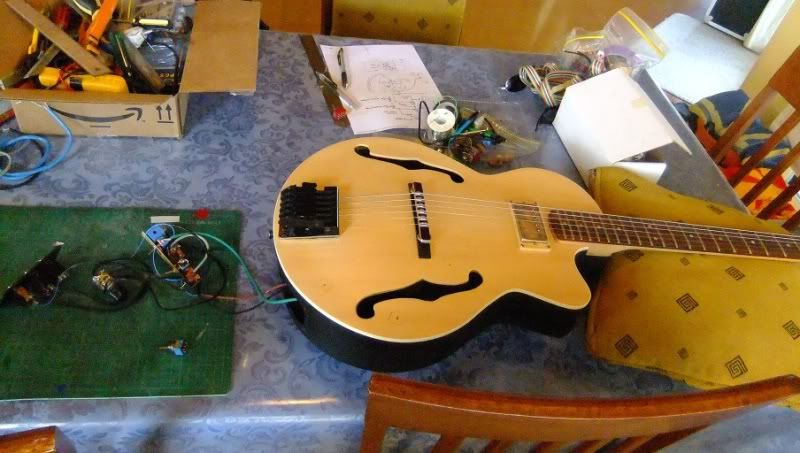 The guitar on the dining table again, old wiring hanging out...and below as it was.. 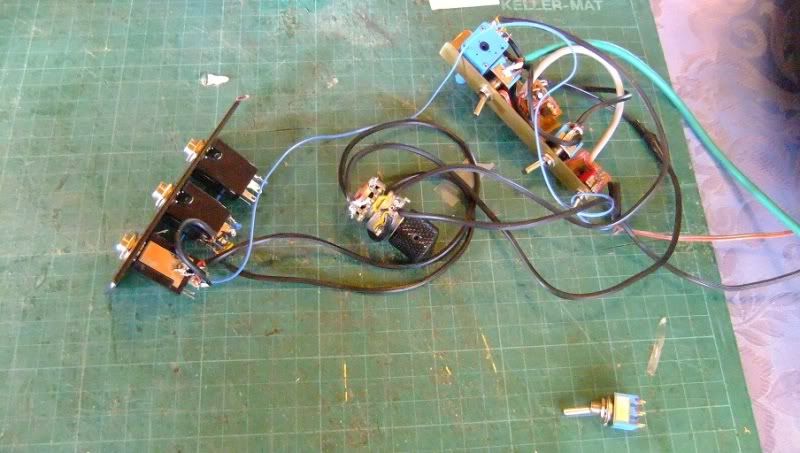 A shot of the three switches and the volume control plate, just prior to rewiring... .... I have done the full thing including the three buffers and been pretty meticulous about it. The blend stereo side of things is all on one plate and connected to the master volume plate that holds the HB switches and three buffers by a 4 core shielded cable...before going to the separate outputs. It would appear to be working correctly and don't think we need go down a rabbit hole with harmonics and string theory LOL before we get some progress on things here. I suspect that the MAG might be a problem, cant quite understand it so might have made a mistake wiring it or something...it is completely noiseless so I don't think that a coil is out, perhaps it is just a particularly weak HB (it is an original gibson), it all seems a little odd that this is not producing a typically big HB sound. I adjusted the pickup closer, etc. The blend and pan seem to be working well, better than before and only a slight increase in volume and either end it seems...less than before. It also appeared to be cutting pretty much all of the sound of one pickup to the other at the extremes of the blend throw so anything to do with cancellation should be revealed when one signal is turned off... |
|
|
|
Post by JohnH on Dec 23, 2011 1:01:25 GMT -5
That looks like nice work, and it seems the system is functioning. If the Mag is just as quiet if disconected from the buffer and wired passively, then I guess it just needs a boost. If its getting a good sound when only connected passively(buffer disconected), and is losing tone/volume when the buffer is wired to it, maybe the buffer is not quite right, but I think you said before that the pickup sounds good with the buffer, just the volume is low.
Do you want to replace the mag buffer with one with a few db of gain? and if so can you judge how many dbs? - I tend to assess such questions by recording a reference level, such as from the piezo or another guitar, and then the pup needing boosting, and see how many db the recording software wants to amplify by to equalise the two levels.
|
|
|
|
Post by 4real on Dec 23, 2011 1:45:53 GMT -5
I want to do a bit of investigating into the HB, perhaps something is amiss with the wiring or the switching...it does not sound out of phase or anything that simple, nor split....but really, should not be that low with such a pickup.
The piezo is much louder, as it should be with a preamp, but then, not as loud as my tele through the same amp and lead in a direct comparison.
Such a low output does worry me, the Mag in particular though is extremely low and supposed to be the dominant sound in my 'ear' for the thing.
Rather than amplify something that might be faulty here, I'd like to get to the bottom of this.
The buffers are well made and would appear to be functioning as expected. Would sound pass at all if this was not so? It could be possible to have damaged one but the other two were unused and obviously sound is coming out ok.
If we need to boost things, I only have limited parts (plenty of those to make the buffers however), though I might have some preamps about we could try I guess.
My expectation is, and I don't think unreasonable, is that the guitar, with an HB in the neck position should produce a reasonably strong output, even without the buffer...and as such, it would appear something is amiss here. Perhaps I need to consider a replacement pickup, but this thing is genuine and seems to be reading ok...
So, when I get a moment I will disconnect all the switches perhaps and wire it direct and then through the system to the preamp and try and see what is going on. I might need to take the whole thing out and cheak it...at an outside, perhaps I will have to use another pickup or compare. I have an old "duncan designed" HB from the old squire strat that is supposed to be a copy of a JB in the bridge position. Rather than preamp things, perhaps this would be a better option and worth getting out and doing a comparison test perhaps.
|
|
|
|
Post by newey on Dec 23, 2011 9:16:51 GMT -5
Have you put the meter to the HB? That might disclose a problem.
If I recall, this was an older pickup and magnets can degrade over time. Of course, the meter won't tell you that. Swapping it out would seem to be a PITA, but might be the only way to really tell.
|
|
|
|
Post by reTrEaD on Dec 23, 2011 9:35:33 GMT -5
Have you put the meter to the HB? That might disclose a problem. Good idea! Measuring the resistance will tell you if there is a wiring issue. You don't really care if the resistance is ten percent off of the nominal spec, but if it isn't something close to what it's supposed to be... If I recall, this was an older pickup and magnets can degrade over time. Of course, the meter won't tell you that. Swapping it out would seem to be a PITA, but might be the only way to really tell. Maybe just a "physical" version of the screwdriver test? How difficult is it to pry the screwdriver up from the polepieces on this pickup? How does that compare to another pickup of the same type? Granted, you won't have numbers to compare. But if there is a large disparity in the amount of force necessary, you should be able to feel the difference. |
|
|
|
Post by ashcatlt on Dec 23, 2011 11:19:13 GMT -5
There really has to be a problem with the S/P switching somewhere. It really must be noticeably louder and darker in series mode, and if that ain't happening...
You can test that part without taking it apart. Measure R between the "hot" and "not hot" outputs from the switch. It should read close to the full HB in series, and a quarter that value in parallel. If somehow it's stuck in P mode, it might explain why it seems so quiet.
|
|
|
|
Post by thetragichero on Dec 23, 2011 12:52:45 GMT -5
If I recall, this was an older pickup and magnets can degrade over time. unless it was thrown in a drawer with a bunch of strong magnets, alnico magnets lose roughly 2% of their gauss over a 100 year period so i would assume it's not the case |
|
|
|
Post by JohnH on Dec 23, 2011 14:21:49 GMT -5
There really has to be a problem with the S/P switching somewhere. It really must be noticeably louder and darker in series mode, and if that ain't happening... You can test that part without taking it apart. Measure R between the "hot" and "not hot" outputs from the switch. It should read close to the full HB in series, and a quarter that value in parallel. If somehow it's stuck in P mode, it might explain why it seems so quiet. There's something in that! Definately Series is louder than Parallel, and unmistakably so, and the overall resistance being 1/4 in P what it is in S (could be a bit different if unbalanced coils). In this case though, the series sound may not actually be darker. What darkens/brightens the sound in passive S/P is the interaction with the cord, which in this case is seperated by the buffer. I found this to be the case on my bufferd LP with rotary switchs on each pickup.e John |
|



























